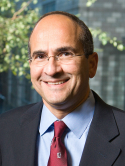Reconstruction of extensive partial or total sacrectomy defects with a transabdominal vertical rectus abdominis myocutaneous flap Journal Article
| Authors: | Glatt, B. S.; Disa, J. J.; Mehrara, B. J.; Pusic, A. L.; Boland, P.; Cordeiro, P. G. |
| Article Title: | Reconstruction of extensive partial or total sacrectomy defects with a transabdominal vertical rectus abdominis myocutaneous flap |
| Abstract: | Following partial or total sacrectomy, extensive soft tissue defects are frequently created. These ablations typically involve an anterior and a posterior approach, creating a large communication between the abdominal cavity and the central gluteal region. Local flap options are usually not sufficient for definitive closure of these large defects. We have found that the most useful option for reconstruction in these cases is a vertical rectus abdominis myocutaneous (VRAM) flap, passed transabdominally through the peritoneal cavity into the sacral defect during the initial anterior-approach portion of the procedure and then inset following completion of the posterior-approach final resection. Advantages of the VRAM flap are that it can supply ample skin, as well as soft tissue bulk, is easy to perform, and does not require microvascular techniques.Utilizing a prospectively maintained database, all patients over the last 14 years who underwent reconstruction utilizing a transabdominal VRAM flap following extensive partial or total sacrectomy with intraabdominal communication were identified. A retrospective chart review was then performed. Our study population consisted of 12 patients with a mean age of 58.5 years. Following sacrectomy, all patients underwent reconstruction with a VRAM flap. Flap sizes averaged 9.1 x 27 cm. Early flap complications included 3 small areas of flap necrosis at the distal, superior portion of the flap, 2 of which required minimal operative intervention of debridement and reclosure. No late flap complications have occurred, and all 12 patients completely healed, with a mean follow-up time of 29.1 months.Following sacrectomy, extensive soft tissue defects are created in the sacral area and communicate with the abdominal cavity. In these situations, we have found the inferiorly-based pedicled VRAM, passed transabdominally, to be the most reliable and useful choice of flap reconstruction. It has a low incidence of complications, low morbidity, and is easy to perform with a high success rate. Copyright © 2006 by Lippincott Williams & Wilkins. |
| Keywords: | osteosarcoma; adult; clinical article; treatment outcome; aged; aged, 80 and over; middle aged; bone tumor; cancer surgery; excision; surgical technique; reconstructive surgical procedures; retrospective studies; review; surgical flaps; cancer radiotherapy; prospective studies; postoperative complication; postoperative complications; sacrococcygeal region; malignant fibrous histiocytoma; myocutaneous flap; rectum cancer; soft tissue defect; chordoma; sacrum; soft tissue neoplasms; rectus abdominis; colostomy; rectus abdominis muscle; sacrectomy; sacrectomy reconstruction; vram flap; abdominal wall musculature; transabdominal vertical rectus abdominis myocutaneous flap |
| Journal Title: | Annals of Plastic Surgery |
| Volume: | 56 |
| Issue: | 5 |
| ISSN: | 0148-7043 |
| Publisher: | Lippincott Williams & Wilkins |
| Date Published: | 2006-05-01 |
| Start Page: | 526 |
| End Page: | 530 |
| Language: | English |
| DOI: | 10.1097/01.sap.0000205772.15061.39 |
| PUBMED: | 16641629 |
| PROVIDER: | scopus |
| DOI/URL: | |
| Notes: | --- - "Cited By (since 1996): 16" - "Export Date: 4 June 2012" - "CODEN: APCSD" - "Source: Scopus" |
Altmetric
Citation Impact
BMJ Impact Analytics
Related MSK Work








